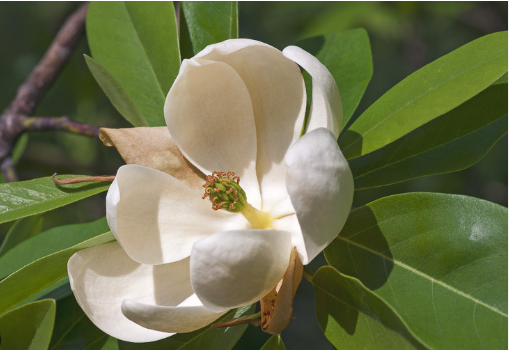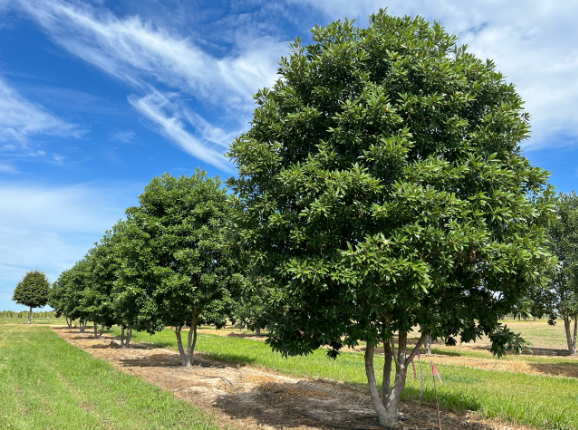Sweetbay magnolia is just one of the familiar names for Magnolia virginiana. Named for the locale of its first discovery, North America, early colonists introduced sweetbay magnolia to England. This semi-evergreen to evergreen broadleaf tree found favor for its white, lemon-rose-scented flowers and its green leaves with silvery undersides. Among the unique facts related to this tree, the name of a swamp in Massachusetts was renamed in its honor. Although it is native to the Southern United States, a colony of sweetbay magnolia was found in Massachusetts in 17th centuary. The magnolia swamp, as it came to be called, drew attention of plantsmen, poets, preachers and tourist-trade seekers. The swamp remains a tourist attraction to this day. Here is more about the history of this tree!
- Native American Uses: Before European settlers arrived in North America, Native American tribes like the Cherokee, Chickasaw, and Choctaw had already discovered the benefits of the Sweetbay Magnolia. They used the bark to treat various ailments such as fever, rheumatism, and coughs. The wood was also used to make furniture and other household items.
- European Arrival: The Sweetbay Magnolia was first introduced to Europe in the late 17th century by a missionary and botanist named John Banister. He brought the tree from Virginia to England, where it became a popular ornamental plant. The Bishop of London, Henry Compton, played a significant role in its cultivation and helped to spread its popularity throughout Europe.
- The First Magnolia in England: In 1731, a famous naturalist and artist, Mark Catesby, documented the Sweetbay Magnolia in his book “The Natural History of Carolina, Florida, and the Bahama Islands.” This was the first magnolia species to reach England, and it quickly became a favorite among gardeners and botanists.
- The Sweetbay Magnolia in the United States: The Sweetbay Magnolia is native to the Atlantic and Gulf Coast Plains of the United States, from New York to Florida and westward to eastern Texas. It is a versatile tree that can be found in various habitats, including swamps, marshes, and along streams. The tree’s ability to adapt to different environments has made it an essential part of the region’s ecosystem.
- Modern Uses: Today, the Sweetbay Magnolia is still highly valued for its beauty and medicinal properties. Its flowers are used in the perfume industry, and the wood is used for furniture and other small wooden items. The tree also plays a crucial role in the ecosystem, providing food and shelter for various animals, including birds, squirrels, and deer.

Characteristics of Sweetbay Magnolia
- Native to the southeastern United States, from Texas to New Jersey, and found as far north as Massachusetts and Long Island.
- A small tree or large shrub, growing up to 20 meters tall but usually shorter in its northern range.
- Smooth, thin bark that is irregularly furrowed and composed of small plates, mottled and aromatic when crushed.
- Winter bud is up to 2.5 cm long and finely silky.
- Leathery leaves are deciduous in the northern range, oblong, elliptic, or oblanceolate, and 8-15 cm long and a third to half as wide.
- The undersides of the leaves are whitish and finally hairy, contrasting with the deep green hairless upper side.
- Large, fragrant, creamy-white flowers bloom in late spring and early summer, with a sweet lemon scent.
- Fruit is a cone-like aggregate of red seeds that mature in the fall.
- Prefers moist, somewhat acidic soil and can tolerate wet conditions, making it suitable for planting near water features or in low-lying areas.
- Can be grown as a tree with a single trunk or as a multi-stemmed shrub.
- Adaptable to full sun or partial shade.
- Not a problem-free tree, but generally resistant to pests and diseases.
- Can be grown in urban areas with limited space for horizontal crown expansion.
- Suitable for use in U.S. Department of Agriculture plant hardiness zones 5 through 9, the tree tolerates coastal conditions, boggy soils and dense clay.
- The roots are shallow and wide-spreading and adaptable to different soil types. They also have a beneficial relationship with mycorrhizal fungi.
- Reaching 12 to 20 feet high with an equal spread, sweetbay magnolia works as a small shade tree or striking shrub border specimen where wind exposes its leaves’ silvery undersides.
- On average, it can live for 80 to 120 years.
Cultivars of Sweetbay Magnolia

| Cultivar Name | Height | Width | Hardiness Zones | Notable Features |
|---|---|---|---|---|
| Magnolia virginiana ‘Henry Hicks’ | 40 ft | 20 ft | 5-9 | Evergreen foliage, early bloomer |
| Magnolia virginiana ‘Green Shadow’ | 15-20 ft | 10-15 ft | 5-9 | Compact size, deep green foliage |
| Magnolia virginiana ‘Moonglow’ | 30-40 ft | 15-20 ft | 5-9 | Large, fragrant flowers, cold-hardy |
| Magnolia virginiana ‘Apalache’ | 15-20 ft | 10-15 ft | 6-9 | Compact size, dark green foliage, evergreen |
| Magnolia virginiana ‘Northern Belle’ | 25-30 ft | 15-20 ft | 5-8 | Cold-hardy, large flowers, dark green foliage |
| Magnolia virginiana ‘Natchez’ | 20-25 ft | 10-15 ft | 6-9 | Compact size, small leaves, prolific bloomer |
| Magnolia virginiana ‘Bracken’s Brown Beauty’ | 30-40 ft | 20-30 ft | 5-9 | Large, dark green leaves, brown undersides, fragrant flowers |
| Magnolia virginiana ‘Jim Wilson’ | 30-40 ft | 20-30 ft | 5-9 | Large, fragrant flowers, dark green foliage |
| Magnolia virginiana ‘Southern Gentleman’ | 20-30 ft | 15-20 ft | 7-9 | Compact size, dark green foliage, large flowers |
| Magnolia virginiana ‘Satellite’ | 20-25 ft | 15-20 ft | 5-9 | Compact size, small leaves, prolific bloomer |
How To Grow And Care For Sweetbay Magnolia
- Planting: Choose a location with well-draining soil and full sun to partial shade. Dig a hole twice as wide and just as deep as the root ball. Gently loosen the roots and place the tree in the hole, ensuring the top of the root ball is level with the ground. Fill the hole with soil and water thoroughly.
- Watering: Water regularly during the first year to establish a strong root system. After that, it will be relatively drought-tolerant but will still appreciate occasional deep watering, especially during dry spells.
- Fertilizing: Feed your Sweetbay Magnolia with a slow-release, balanced fertilizer in early spring.
- Pruning: Prune in late winter or early spring to maintain its shape and remove any dead or damaged branches. Be cautious not to over-prune, as this can reduce flowering.
- Mulching: Apply a layer of organic mulch around the base of the tree to help retain moisture, suppress weeds, and regulate soil temperature. Keep the mulch a few inches away from the trunk to prevent rot and pest issues.
- Pests and Diseases: Sweetbay Magnolias are generally pest and disease-resistant, but they can be susceptible to scale insects, leaf spots, and powdery mildew. Regularly inspect your tree for signs of these issues and treat them promptly with the appropriate organic or chemical controls.
- Winter Protection: In colder climates, protect your Sweetbay Magnolia from harsh winter winds and frost by wrapping the trunk with burlap or a tree wrap. This will help prevent frost cracks and damage to the bark.
References
- Lady Bird Johnson Wildflower Center: Magnolia Virginiana L.
- University of Florida: School of Forest Resources and Conservation: Sweetbay Magnolia
- The Ohio State University: Magnolia Virginiana
- The American Horticultural Society A to Z Encyclopedia of Garden Plants; Christopher Brickell and Judith D. Zuk
- Magnolia Virginiana in Massachusetts; Peter Del Tredici
- Eat the Weeds: Sweetbay Magnolia